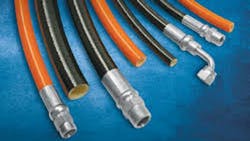When NOT To Use Wire-Reinforced Hydraulic Hose
A recent client engaged me to design the hydraulic steering circuit for a luxury motor yacht he was building. During installation, the installer questioned why I specified thermoplastic hose for the sections where stainless steel tube was not able to be used.
For those not familiar, thermoplastic hose (Synflex, Parflex, etc) is entirely reinforced with synthetic fibers. And this is advantageous in a marine application like this one, for a couple of reasons.
The first is corrosion resistance. The steel-wire reinforcement of a conventional hydraulic hose is prone to corrosion--despite the fact it's covered with a rubber sleeve. This outer sleeve tends to be porous, and is therefore not an impermeable barrier to the saltwater environment. So corrosion of the hose's wire reinforcement and resulting reduction in its service life is eliminated by using a thermoplastic hose.
The second reason is noise propagation, which is almost always a significant issue on boats and ships. Even though the selective installation of wire reinforced hose can be effective as a noise damping element, the steel-wire reinforcement still provides a conduit to conduct sound-energy excited vibration. The use of thermoplastic hose eliminates this sound bridge, making it a more effective noise insulator.
Note however, that thermoplastic hose does have a higher level of volumetric expansion under pressure than wire reinforced hose. And while this too can be advantageous in the control of noise (it provides a natural damping effect), this further reduction in stiffness is undesirable in high performance applications requiring fast response.
In this application, as is always the case, using the wrong type of conductor can be a very costly mistake. And to discover six other costly mistakes you want to be sure to avoid with your hydraulic equipment, get "Six Costly Mistakes Most Hydraulics Users Make... And How You Can Avoid Them!" available for FREE download here.
About the Author
Brendan Casey Blog
Author
Brendan Casey is a war-weary and battle-scarred veteran of the hydraulics industry. He's the author of The Hydraulic Troubleshooting Handbook, Insider Secrets to Hydraulics, Preventing Hydraulic Failures, The Definitive Guide to Hydraulic Troubleshooting, The Hydraulic Breakdown Prevention Blueprint and co-author of Hydraulics Made Easy and Advanced Hydraulic Control. And when he's not writing about hydraulics or teaching it, Brendan is flat-out helping consulting clients from a diverse range of industries solve their hydraulic problems. To contact him visit his company's Website:
www.HydraulicSupermarket.com

Leaders relevant to this article:
